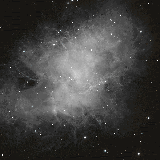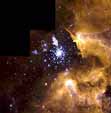
| Bad Astronomy |
|
|
|
BA Blog
|
|
Q & BA
|
|
Bulletin Board
|
| Media |
|
|
|
Bitesize Astronomy
|
|
Bad Astro Store
|
|
Mad Science
|
|
Fun Stuff
|
| Site Info |
|
|
|
Links
|
| RELATED SITES |
| - Universe Today |
| - APOD |
| - The Nine Planets |
| - Mystery Investigators |
| - Slacker Astronomy |
| - Skepticality |
Buy My Stuff

Keep Bad Astronomy close to your heart, and help make me
filthy rich. Hey, it's either this or one of those really
irritating PayPal donation buttons here.
Supernova 1987A: The Future
Week of March 27, 2000
These past few weeks' Snacks have been a bit longer than usual, and have perhaps more detail in them than the usual ones. However, I have enjoyed writing about what is still my favorite object in the sky, Supernova 1987A.
As I go back and read what I wrote, the history and physical nature of this object might be a little intimidating. As it happens, I have a remedy for that. SN87A generates a lot of interest on the web and in the USENET newsgroups, and so much misinformation was being spread about the rings and how they formed that I decided to post a timeline of the supernova, describing what happened at various times during its life. With a little editing, I present what I posted below. This is the last in the Supernova 1987A series, and I think this timeline will wrap it up pretty well.
- Approximately one to five million years ago: A star with about 20 times
the mass of the Sun forms from a local patch of gas in the huge
Tarantula Nebula gas complex.
For a long time, it was a simple main sequence (but very
massive and hot) star.
-
A few hundred thousand or so years ago:
The star became a red supergiant (RSG), and started to blow a slow,
dense wind. This wind was not spherical, but had some degree of axial symmetry
(in other words, it may have not been exactly
spherical, but squashed like an oblate spheroid). This was
most likely not caused by simple rotation of the star,
since RSG's rotate slowly. Perhaps it had a companion, like
a close binary, or (my pet theory) a closeby superjovian
which spun up the star when the RSG expanded around it.
Many of the extrasolar planets so far discovered have been much
more massive than Jupiter, and close in to their parent stars.
When the precursor to SN87A expanded to a red supergiant, it would
have engulfed any closeby planets, and orbital physics would
cause the bloated star to increase its spin.
No matter its cause, the wind emitted was more dense along the equator,
and less towards the poles. This is important later.
-
Approximately 20,000 - 40,000 years ago:
The star turned into a blue supergiant (BSG).
The wind became much faster and less dense. This wind catches
up with the older RSG wind. Since the old wind is less dense in
the polar direction, the BSG wind moves faster that way.
It is slower in the equatorial direction, so you get a
"bipolar outflow"; a funny shape like an hourglass. Two lobes
form up and down, and it gets pinched in the middle. The middle
pinch forms the inner ring we see. The gas gets compressed
by the shock of the BSG slamming into it, so the hourglass shape
has some finite thickness. It is still pretty thin, compared
to its overall size. Its length is about 2 parsecs.
Think about each lobe now. It is very roughly spherical, but squashed a bit. Somehow (the exact mechanism is unknown right now) each lobe gets a slight overdense region around its middle. These form the so-called "outer rings". The stage is now set, but note that this is still some 10,000 to 20,000 years before the star explodes.
- Late 20th Century: the star is noticed by the astronomer Sanduleak,
and is registered in his catalog of stars in the region by its
coordinates: -69 202. The star is logged as blue, and spectra taken
in 1977 show nothing unusual about the star. That's because the
important changes are taking place deep in its core, where we
cannot see them with our instruments. The rings are there,
but the vast distance to the system dims the rings
into invisibility. The star was hot, but also may not have been hot enough
to make the rings glow back then.
-
February 24, 1987:
KABOOM! Sanduleak -69 202 transforms itself into SN1987A.
1057 or so ultraviolet and x-ray photons scream out
from the inferno. Some small fraction
hit the ring system, causing it to glow. The gas in the
hourglass is not terribly dense, nor is it thick, so it glows
feebly. The rings, however, are denser, and the glow is more
pronounced. 50,000 parsecs away, we see three rings glowing
with almost no trace of the hourglass nebula itself.
-
1987-1990: For a short period of time (about two years), light travel
time effects complicate matters here on Earth. Those effects are
complicated and it would be difficult to explain them here. Basically,
the vast size of the system of rings -- over six light years from
top to bottom -- means that it takes a beam a light a long time
to get from one end to the other. That makes observations of
the system complicated, but it also gives us clues to the origin and makeup
of the rings.
-
1990-1995:
The rings fade as the gas recombines. This fading has helped us quite
a bit in finding the temperature, density and even the structure of
the gas.
-
 1996: Hubble images reveal that the supernova blast itself is
measurably increasing in size. From the spectra we knew it was expanding
at 5000 kilometers per second, but this was the first time such
a young supernova was ever seen in such detail. My friend Jason Pun
was the person who worked on those images, and indeed is still toiling
very hard on understanding the supernova and the rings.
1996: Hubble images reveal that the supernova blast itself is
measurably increasing in size. From the spectra we knew it was expanding
at 5000 kilometers per second, but this was the first time such
a young supernova was ever seen in such detail. My friend Jason Pun
was the person who worked on those images, and indeed is still toiling
very hard on understanding the supernova and the rings.
-
1997: The first true change in the ring shows up, when a
spot in the north side of the ring actually begins to brighten.
The hotspot becomes quite noticeable, but it is the only one seen.
-
2000: The hotspot is suddenly joined by a half dozen other spots on the
opposite side of the ring. This indicates that the fastest moving
pieces of the supernova are in the form of bullets of gas, and
that the main front of the blast wave is slower.
-
Now + a short time, maybe three to five years: The bulk
of the expanding debris from
the explosion, moving outwards at perhaps 10% the speed of light,
slams into the inner ring. The ring starts to glow as the debris
heats it up. These fireworks may be bright enough to light up the
the outer rings as well. The inner ring will slow the
debris somewhat, but cannot stop such an onslaught. In about
twenty years, the inner ring is destroyed, obliterated by the
star that once created it. Some hundreds of years later the debris
hits the outer rings as well, which suffer the same fate. Their
legacy remains, however: the debris fought a long time to get past
the rings, and like water flowing around a sandbar, the debris itself
is shaped by the rings.
-
The future: Eventually, we get something that may look quite
a bit like the
 Crab Nebula. There is some evidence that the Crab
has a ring of emission in the middle. Did the progenitor of
the Crab Nebula have a ring system like Sanduleak -69 202?
Perhaps astronomers a few hundred or thousands of years
from now will see a ring shape in the debris
in the middle of the nebula surrounding Supernova 1987a,
which is basically the ghost of the inner ring.
Crab Nebula. There is some evidence that the Crab
has a ring of emission in the middle. Did the progenitor of
the Crab Nebula have a ring system like Sanduleak -69 202?
Perhaps astronomers a few hundred or thousands of years
from now will see a ring shape in the debris
in the middle of the nebula surrounding Supernova 1987a,
which is basically the ghost of the inner ring.
 In the meantime, we have other potential supernovae to study.
There is a star named Sher 25 located in our own Milky Way
galaxy, and it has some surrounding gas that bears an eerie
resemblance to the rings of 87A. It too is a supergiant,
and will someday explode. This time, though, the event
will take place close enough that the detail will be much
better, and we'll learn a lot more. Who knows when it will go?
Maybe tonight, or maybe ten thousand years from now.
But not much longer after that. I can't wait!
In the meantime, we have other potential supernovae to study.
There is a star named Sher 25 located in our own Milky Way
galaxy, and it has some surrounding gas that bears an eerie
resemblance to the rings of 87A. It too is a supergiant,
and will someday explode. This time, though, the event
will take place close enough that the detail will be much
better, and we'll learn a lot more. Who knows when it will go?
Maybe tonight, or maybe ten thousand years from now.
But not much longer after that. I can't wait!
For tons of images, explanations and even nifty animations, go to the Space Telescope Science Institute's webpage about supernovae. They have great stuff there.
|
|
| THE PANTRY: ARCHIVE OF BITESIZE SNACKS |
|
|
| Subscribe to the Bad Astronomy Newsletter! |
| Talk about Bad Astronomy on the BA Bulletin Board! |